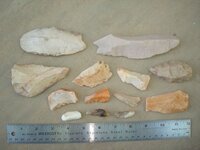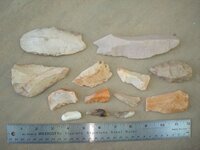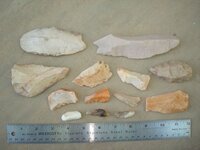uniface
Silver Member
The last few days I've been absorbed in a gift box of artifacts (a dozen of them) collected by Blindpig (and a friend of his) when he lived in Australia. Ranging in size from tiny tulas to large (5"+) Leiliras, they're fascinating relics of a very different stone age than ours. If places like Florida and Texas were parallel artifact worlds that diverged from the eastern mainstream, going their own ways, Australia was a parallel universe.
What's called the Levallois Point strategy of the (European) Mousterian era is the foundation of their technology. (Repeating a link in case you missed it in the other post http://en.wikipedia.org/wiki/Levallois_technique ) I've seen this from Florida and the deep south here (age unknown), and there's a brief appearance it makes in the east during the Hopewell era, but it seems scarce overall.
The little tulas are even more exotic yet. These started with knapped-off bulbs of percussion of agate and chalcedony, flaked down into chisels and gravers. Like the announcer says, "And now for something completely different !"
Rather than carrying on about stuff I barely understand and only encountered a few days ago, I think it would be neat if Blindpig himself (who seems a reticent sort) would step up and take the podium here, since he knows these very well indeed.
What say, Blindpig ?
(Needless to say, Uniface says, "Thank You !")
What's called the Levallois Point strategy of the (European) Mousterian era is the foundation of their technology. (Repeating a link in case you missed it in the other post http://en.wikipedia.org/wiki/Levallois_technique ) I've seen this from Florida and the deep south here (age unknown), and there's a brief appearance it makes in the east during the Hopewell era, but it seems scarce overall.
The little tulas are even more exotic yet. These started with knapped-off bulbs of percussion of agate and chalcedony, flaked down into chisels and gravers. Like the announcer says, "And now for something completely different !"
Rather than carrying on about stuff I barely understand and only encountered a few days ago, I think it would be neat if Blindpig himself (who seems a reticent sort) would step up and take the podium here, since he knows these very well indeed.
What say, Blindpig ?
(Needless to say, Uniface says, "Thank You !")
Upvote
0





 ...blindpig Burrp...........
...blindpig Burrp........... ....uses ! And I’ve found ‘em in historic context [WW II] . Now , for the most part where I found many tools you had the last 10,000 yr’s laying right on the hard pan , just had to pick and choose,.. What I “picked” may have not been first choice by an Aboriginal , but they “looked” nice !!
....uses ! And I’ve found ‘em in historic context [WW II] . Now , for the most part where I found many tools you had the last 10,000 yr’s laying right on the hard pan , just had to pick and choose,.. What I “picked” may have not been first choice by an Aboriginal , but they “looked” nice !! 






